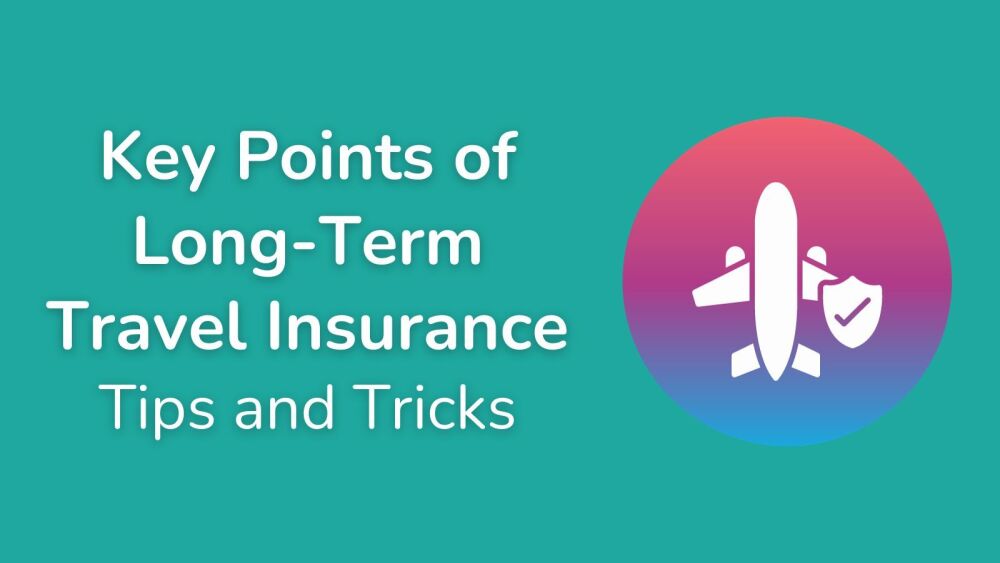Key Points of Long-Term Travel Insurance: Tips and Tricks
Posted on
Long-term travel insurance is required if you are planning a trip abroad of more than 30 days. This type of cover provides emergency protection when you are away from your home country and your regular health insurer for an extended period.
Having long-term travel insurance in place will protect you from unexpected expenses and help you maintain peace of mind throughout your journey.

Who needs long-term travel insurance?
Long-term travel insurance is essential for anyone planning an extended journey abroad, typically lasting more than 30 days. If you're venturing far from home for an extended period, this insurance provides crucial coverage against unexpected emergencies, ensuring you're financially protected throughout your travels.
It’s especially useful for:
-
Gap year students spending months overseas.
-
Digital nomads working abroad.
-
Retirees exploring the world for long stretches.
-
Travellers on sabbaticals or extended career breaks.
For these groups, long-term travel insurance is a smart choice to safeguard your trip.
Core reasons why you need comprehensive cover
When you’re abroad for weeks or months, unexpected issues can quickly become expensive. A comprehensive long-term travel insurance policy can protect you in several ways:
-
Emergency medical care: Cover for hospital stays, GP visits, and medication abroad.
-
Trip cancellation or interruption: Reimbursement if you need to cancel or return early due to illness, injury, or family emergencies.
-
Emergency assistance services: Support with medical transport, replacing lost documents, or finding local healthcare.
-
Lost or stolen luggage: Compensation if your bags or valuables go missing.
-
Personal liability: Protection if you accidentally cause injury to another person or damage their property.
Types of long-term travel insurance
Health and medical cover
This is the most important element. It includes doctor visits, hospitalisation, prescriptions, and sometimes dental emergencies. Many policies also include repatriation, so if you become seriously unwell, you’ll be flown home for treatment.
Evacuation cover
If you’re in a remote location with poor medical facilities, evacuation insurance pays for transport to a suitable hospital, often in another country. This is especially vital for long-term travellers in rural or developing regions.
Trip cancellation and delay
These policies cover pre-paid, non-refundable costs if your trip is cut short or delayed. For example, if you need to fly home for a family emergency, cancellation cover helps you recoup costs.
Baggage and belongings
Protects against lost, stolen, or damaged luggage. Some policies also cover gadgets, though you might need to pay extra for high-value electronics.
Liability insurance
This protects you financially if you accidentally injure someone else or cause property damage.
Duration of cover: single-trip vs. multi-trip
When arranging long-term travel insurance, you’ll need to decide whether a single-trip policy or a multi-trip policy is best.
-
Single trip: One continuous journey, often up to 12 or 24 months. Ideal for gap years, sabbaticals, or retirement trips.
-
Multi-trip (annual cover): Lets you take several shorter trips during a 12-month period. Each trip has a maximum length (often 30–90 days), but you can travel multiple times. This works well for frequent travellers or digital nomads who return home in between.
Can travel insurance be extended?
One common question is whether you can extend travel insurance while abroad.
-
Some providers allow you to extend your policy if your trip lasts longer than expected, but you usually need to request this before your current policy expires.
-
Not all insurers allow extensions, so if flexibility matters, look for companies that offer this option.
-
In some cases, you may need to buy a new policy — though this can leave gaps in cover if your new policy excludes pre-existing events.
Always check with your insurer before you set off, especially if you think your travel plans might change.
Pre-existing medical conditions
Declaring pre-existing medical conditions is essential when buying long-term travel health insurance. Hiding information could void your policy.
-
Be upfront about your health history when applying.
-
Some insurers cover conditions that have been stable for at least 6–12 months.
-
Others may exclude certain conditions but still offer general medical cover.
Age limits
Age is another factor that affects eligibility. Many long-term travel insurance policies have an upper age limit, often 65 or 70. Some specialist providers, however, cover older travellers up to 80 or beyond.
If you’re over the limit, you may need to:
-
Take out shorter-term policies and renew them as needed.
-
Look for specialist insurers that cover older age groups.
Risky activities and disclosure
Planning adventurous activities such as scuba diving, trekking, or skiing? Always check whether your insurance covers them.
-
Some policies include popular sports automatically.
-
Others require you to pay extra for “adventure sports” cover.
-
If you don’t disclose these activities, your policy may be invalid.
What long-term travel insurance doesn’t cover
Even the best policies have exclusions. Common scenarios where you might not be covered include:
-
Incidents that happen while under the influence of drugs or alcohol.
-
Travelling against government advice for your destination.
-
Undisclosed pre-existing medical conditions.
-
High-risk sports or jobs not declared on your policy.
-
Claims for lost belongings if you left them unattended.
Always read the small print before committing.
Choosing a provider
Not all travel insurers are equal. When selecting long-term travel insurance, compare:
-
Financial strength and reliability of the provider.
-
Reputation and customer reviews.
-
Scope of coverage — check the fine print carefully.
-
Emergency assistance services — ideally with 24/7 support worldwide.
Well-known providers of long-term travel insurance include Allianz, World Nomads, and Staysure (popular with UK travellers).
Comparing quotes and saving money
The cost of long-term travel insurance varies widely, so it pays to compare quotes.
-
Use comparison sites to get an overview, but always check the policy wording.
-
Increase your deductible to reduce premiums.
-
Look for discounts via family plans, student organisations, or certain bank accounts.
-
Avoid unnecessary add-ons — only pay for what you need.
Application process
Applying for long-term travel insurance is usually straightforward:
-
Fill in your trip details and health information online.
-
Submit any required documents (passport, medical history).
-
Review the policy carefully before paying.
-
Carry your documents or digital copies when you travel.
Make sure you apply in advance — some providers don’t let you start cover once you’ve already left home.
Practical tips for managing your policy abroad
Once you’ve purchased your policy, there are a few ways to make life easier if you need to claim:
-
Keep digital and paper copies of your policy details and emergency contact numbers.
-
Save the claims hotline number in your phone.
-
If you need treatment, get written confirmation and receipts for all costs.
-
Use your insurer’s app if they provide one, as it can speed up the claims process.
-
Notify your insurer as soon as possible if something happens — delays can cause issues with claims.
Final word
Long-term travel insurance is a smart choice for anyone planning to be abroad for more than a month. From medical emergencies to lost luggage, this cover ensures you’re financially protected and supported when things don’t go to plan.
Compare multiple providers, declare health conditions honestly, and check whether extensions are possible if your trip runs longer than expected. With the right policy in place, you can enjoy your travels knowing you’ve safeguarded your health, finances, and peace of mind.
